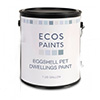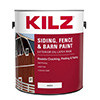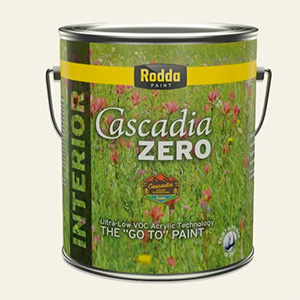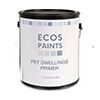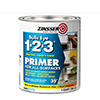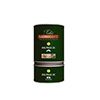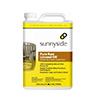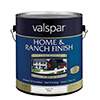Best Chicken Coop Paint (2025)
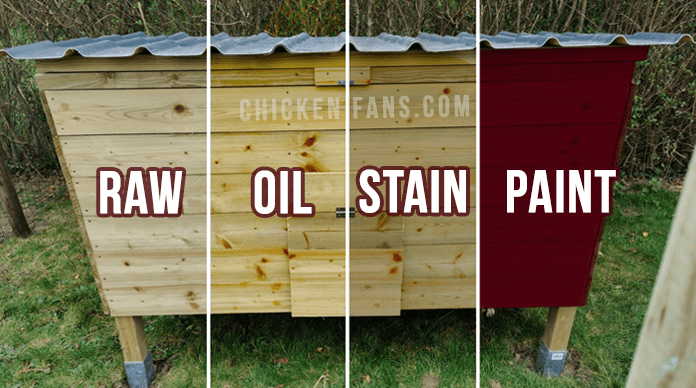
Chicken Fans is reader-supported. When you buy through our links, we may earn a commission. Learn more about our privacy policy and disclaimer.
Protect your chicken coop by giving it a fresh coat of paint! Not only does painting your coop fortify it against the elements, but it also simplifies maintenance by making it easier to clean. Plus, a well-painted coop serves as an effective deterrent against red mites and other unwelcome parasites.
But hold on before you search through your basement for leftover paint! These random paint tins you have might not be the best fit, especially when considering the health of your chickens.
No worries, though – we’ve conducted thorough research for you. Here are our top picks!
For paint and oil, you have many options. Before we dive deep into discussing all things to look at, here are the runner-ups and alternatives.
Best Chicken Coop Paints
The outside of the coop must withstand weather conditions. The interior must be easy to clean and provide a safe place for your chickens to eat and roost. Use inside paint for the nesting boxes.
Best Chicken Coop Paint for Outside
- ECOS Zero VOC Paints
- ECOS Non-Toxic Eggshell Pet Dwellings Paint
- KILZ Exterior Siding, Fence, and Barn Paint
- BEHR Exterior Barn and Fence Paint
- Valspar Barn and Fence Latex Paint Red
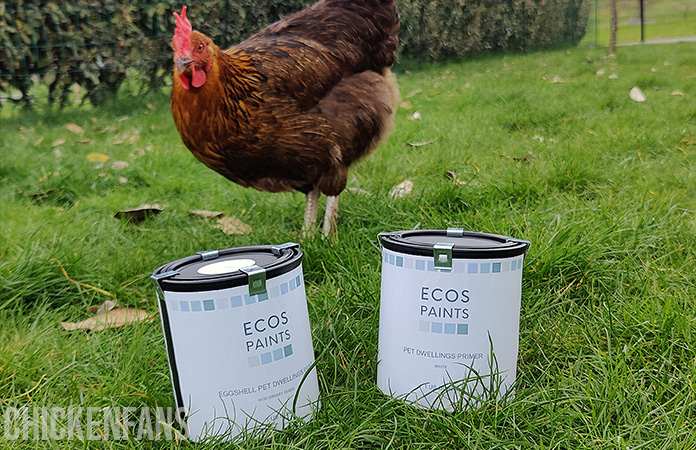
Best Chicken Coop Paint for the Interior
- ECOS Eggshell Pet Dwellings Paint
- ECOS Zero VOC Wood Stain
- Rodda Paint CASCADIA ZERO
- Valspar Duramax Exterior Latex Flat Paint
- Rubio Monocoat Zero VOC Oil Finish
Best Chicken Coop Paint Primers
Chicken Coop Paint Runner Ups
These did not make it to the list but are considered great alternatives:
While boiled linseed oil and tung oil do not contain any VOC, they contain small toxic compounds like aldehydes. If you decide to use oil, let it dry out long enough. You can also opt for polymerized linseed oil, which is non-toxic but dries more quickly than raw.
Always check the datasheet (PDS) and safety data sheet (SDS) of the products you work with. We did thorough research, but the composition of these products can change over time or have regional differences.
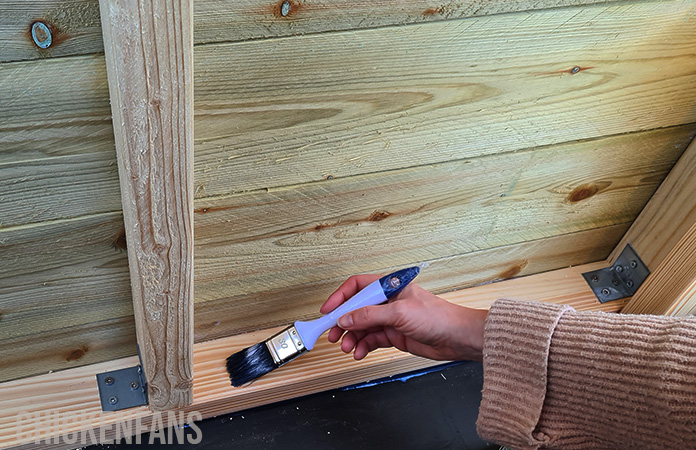
Chicken Coop Paint vs. Oil vs. Stain
There are three choices available to you when it comes to painting the interior or exterior of a chicken coop, which are paint, natural oils, or wood stain.
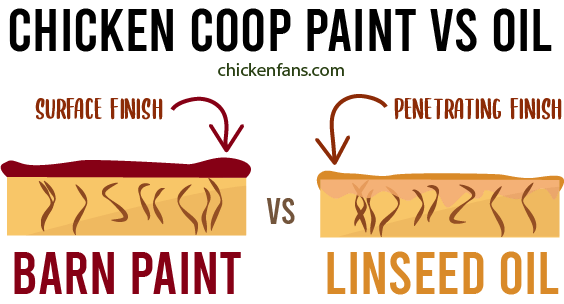
Paint will form a coating on top of the wood as protective skin. Oil will penetrate deep into the wood’s pores, creating an enamel-type layer that keeps the natural look of the wood. Stain is similar to oils but won’t penetrate as much and remain on the surface.
Thereby they change the color of the wood so that the final chicken coop look will have less of the original wood structure.
Paint
Exterior paints are highly durable and can withstand harsh weather conditions such as rain and sun, as well as normal wear and tear. On the other hand, paint requires a solid base coat, a primer, which means you may have to apply multiple coats to the chicken coop. An alternative option is to use a paint-and-primer combo product.
Latex paint dries quicker than oil-based alternatives, so go for latex paint if you want to get the job done quickly. Oil might be preferred if you paint the chicken coop before you get your chickens, as it needs more time to dry.
Oil
If you want to keep the natural look of wood, oil is your friend. A word of warning here, oils can come with a high concentration of toxic VOCs that can lead to chronic health issues for your chickens. Make sure to use zero VOC oils.
Popular food-safe oils used in poultry and pet cages are linseed and tung oil. Linseed oil is easy to apply but a little less durable, so that you might need a couple of layers. Tung oil is more difficult to apply correctly, but it’s naturally water-resistant and dries faster than raw linseed oil. If it’s durable enough for ships, it’s also suitable for the chicken coop.
One of the downsides of oil is that you should re-apply it every year. It can also become greyish over time.
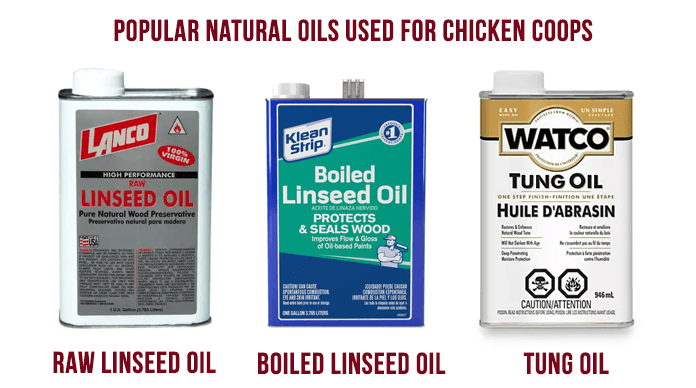
Boiled linseed oil dries faster and does not contain any VOC but can contain other toxins like aldehydes. An alternative is polymerized linseed oil, another non-toxic oil that dries a little quicker.
Oil is easier to apply than paint, but it has a penetrating odor and needs a lot of time (a couple of days) to dry out completely. You will also need to clean your brushes with turps or white spirits. Always ensure it’s completely dry before letting the chickens inside the coop.
Stain
Wood stain does not penetrate as deep as oil and changes the color of the coop. A good stain helps to revitalize the look of the wood. It does not preserve the condition of the wood as well as oil, but that should not matter too much unless you raise chickens on the deck of a luxury superyacht. A last advantage of stain is that you don’t need a primer.
Outside Paint for the Chicken Coop
For the outside of the coop, self-priming barn paint is an excellent animal-safe option.
Primer
If the paint is not self-priming, make sure to apply a primer or have the first layer in waterproof wood stain, so the paint will stick. You don’t want to skip the primer and find your coop back a couple of months later with the paint coming off.
If you can peel the paint like skin on a sunburn, your chickens will start pecking it. And you won’t like it when they suddenly start pooping red. They won’t ever peck at sound painted wood.
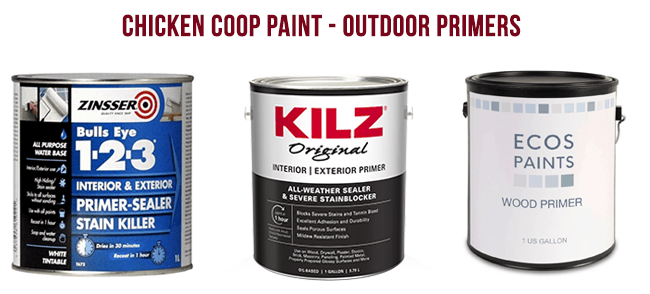
You can choose a primer specific for wood or a generic one for all surfaces, such as Zinsser Bulls Eye 1-2-3. Kilz has an excellent oil-based all-weather primer that will seal stains if your chicken coop needs to survive extreme weather conditions. If you live in a rainy region, you might want to caulk all the cracks and nails in the coop before you apply the primer.
Top Coat Chicken Coop Paint
Most people choose gloss or semi-gloss for the paint, as it will be easier to wash off the dirt. Semi-gloss might be easier to repaint if you ever need to give it an extra layer.
You can find red barn paint in any Home Depot, Walmart, or other regional retailers. It doesn’t need to be barn paint, but make sure it’s exterior paint that can survive cold and warm temperatures and rain. Examples would be exterior latex paint from Sherwin Williams or Behr Marquee Exterior paint, a low VOC paint-and-primer-in-one that is GREENGUARD Gold certified.
If you’re looking to add some color to your chicken coop, most people prefer white or red, but plenty of options are available!
Paint for the Chicken Coop Interior
You want to have low-VOC paints, primers, and stains for the interior.
Chickens have very sensitive respiratory systems. Birds are much smaller than us and are much more susceptible to toxins in the air. Miners used to take sentinel canaries into coal mines: if the canaries died, they knew there were dangerous gases. When you are finished painting or staining the coop, let it dry. Make sure you don’t put the birds back in when there are still solvent aromas and paint fumes in the coop.
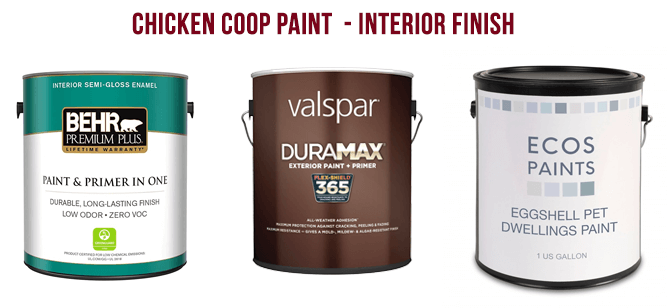
Also, make sure to use an appropriate primer when you decide to paint. If the paint is dry, the chemicals are evaporated, and the paint layer should be inert. The chickens will leave it alone. They don’t have the instinct to chew wood like a parrot. But if the paint starts to peel off, it’s a whole other story, and you don’t want to find your chickens chewing on paint chips.
Our Top Choices for Chicken Coop Paint
Is Paint Toxic for Chickens?
Yes, most paint is toxic for chickens. You want Low VOC or Zero VOC paints. These paints are low in Volatile Organic Compounds, which are incredibly unhealthy for birds.
Green Seal paint standards limit the VOC concentration to 100g/L and prohibit the use of heavy metals and phthalates in paint. MPI’s GPS2 has been the most stringent in North America since 2007 and puts the maximum at 50g/L.
There used to be some concern about lead in paint in the seventies, but that time has long passed. However, low VOC does not necessarily mean the paint has no harmful chemicals. Some paints contain other toxins and carcinogens like phthalates.
Non-Toxic Chicken Coop Paint
ECOS Paints
The people of ECOS PAINTS make the overall best animal-friendly, non-toxic chicken coop paint. They produce non-toxic, zero-VOC water-based paints and stains that are especially suitable for chicken coops and animal cages.
Their pet-friendly paints use environmentally friendly ingredients and a unique mixing process to provide exceptional longevity while protecting pets and animals from the harmful chemicals commonly found in conventional paints.
This means you can use ECOS paints for any animal enclosure, like dog houses, chicken coops, and bird enclosures.
ECOS paints are non-toxic, zero-VOC, without odor, and proudly made in the USA.
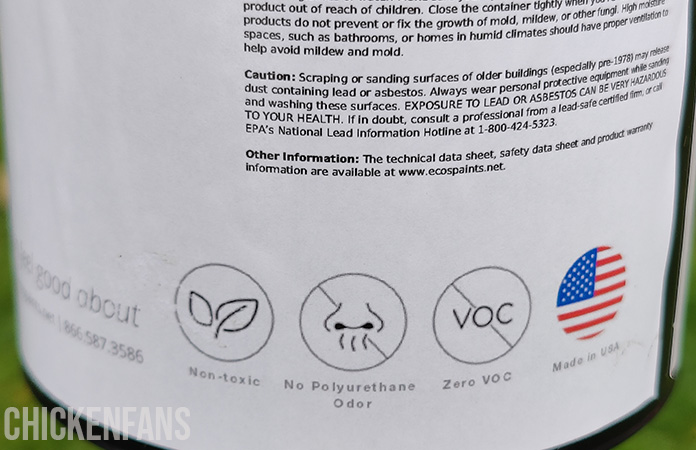
Rodda Paint CASCADIA ZERO
Rodda Paint CASCADIA ZERO is an example of an ultra-low-VOC chicken coop paint. It contains less than 50g/L VOC, has no undesirable chemical compounds such as phthalates or carcinogenic ingredients, and guarantees premium indoor air quality and environmental safety.
Valspar Paints
Another example is Valspar Duramax Exterior Latex Flat Paint. This self-priming paint contains less than 50g/L VOC and is MPI GPS2 certified and LEED-certified (US & Canada), a standard for healthy and green buildings.
BEST ANIMAL-FRIENDLY PAINT
Cheapest Chicken Coop Paint
We’ve tackled a couple of painting options, but what if you are on a budget? A large coop will quickly ask for a gallon of paint after all.
For the interior paints, we would not immediately recommend the zero VOC paints at Home Depot or low-budget retailers, as they sometimes contain other chemicals to compensate for the low VOC concentration, but you can always check the labels.
For the exterior paints, you can look at the cheaper barn paints. They might not give that glossy, shiny slick finish, but it is a chicken coop, after all.
To cut the painting costs of the chicken coop even further, you can check out with friends and family if they have some eco-friendly paint leftovers in their basements. As long as the paint tins are tightly sealed, they should be okay. Other options include recycling centers and yards with drop-off points for old paint.
Chicken Coop Paint Color
For the inside, white or a light color is very popular. The light color makes the coop brighter, which is great when the days are shortening in the winter. It also makes it difficult for parasites like the red mite to hide, as they will be visible when crawling over the white walls. Some people use darker colors for the nesting boxes, creating a cozy place for the chickens to lay their eggs.
For the outside, red is such a popular color that some manufacturers even stopped producing coops in other colors.
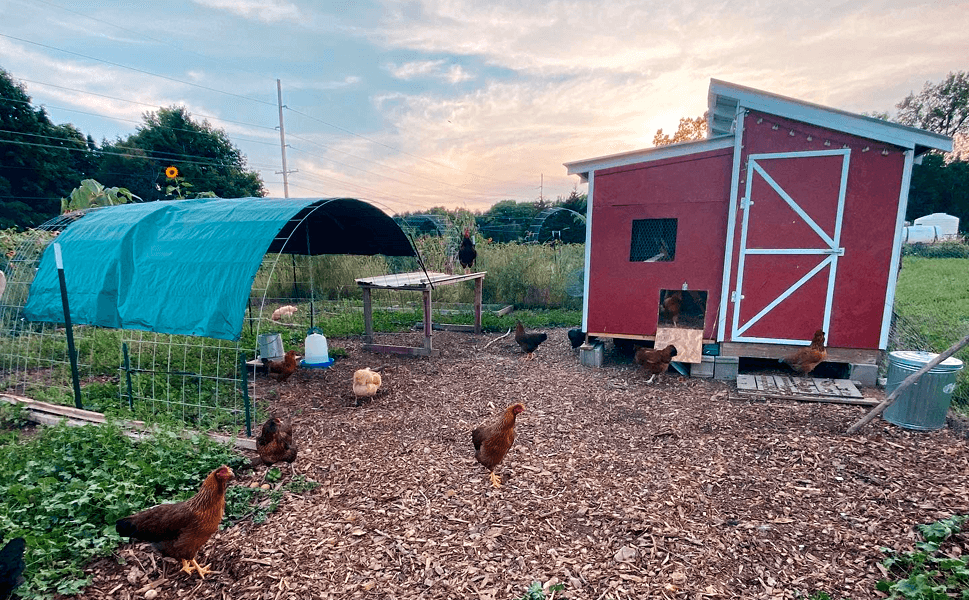
Why are Chicken Coops Red?
Chicken coops are red because people love it when their chicken coop looks like a red and white mini barn in the backyard. That’s why Barn Red and Barn White are very popular choices.
Back in the day, farmers mixed rust in their linseed oils because it kills fungi like mold and moss that grew on the wood. It was a cheap way to keep the moss away and protect the wood from rot. When manufacturers started to produce chemical paints, red was the most affordable pigment, so the tradition continued.
Do you have to paint a chicken coop?
No. You don’t have to paint a chicken coop. The chickens will be fine.
But it will last longer if you paint the outside, and you can clean it easier when it’s painted rather than raw wood. Removing the chicken’s cecal poo from painted surfaces is easier than bare plywood.
Does Painting a Chicken Coop Prevent Parasites?
Painting or staining will not immediately kill red mites or lice inside the coop but will remove many of the rough wood seams for them to hide. It’s not that they won’t find other places to hide, but it certainly helps to get things under control. If the coop’s interior is glossy white, you will see all the little critters crawling around in case of a mite infestation.
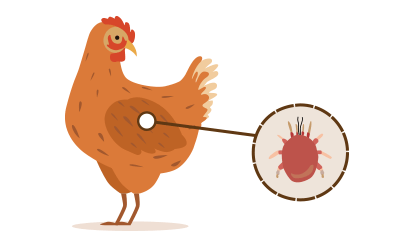
If you need to fight red mites or poultry ticks, clean the coop thoroughly, seal any crevices by caulking the cracks, and paint. A thick primer like Zinsser 123 can fill the nooks and crannies of the coop. We’ve seen people reaching out to more extreme solutions like masonry primer or urethane deck paints for rough surfaces.
Whatever you paint the interior with, ensure it’s safe for the birds. They are predisposed to poor respiratory responses on any paint with high VOC levels or toxins. Not just any paint makes excellent chicken coop paint.
Oil will also discourage any parasite from settling on the wood, as it penetrates the upper layers of the wood. You might have heard of coop paint for mites, but people usually just refer to insecticide or other oils to apply after the coop is fully painted.
It’s scientifically proven that some oils are effective against annoying poultry red mites (Dermanyssus gallinae). However, we won’t recommend using petroleum, diesel, or burnt motor oil, as these all carry carcinogens. If anything, stick with the mentioned oils, like linseed oil, or use mineral oils to treat the coop after finishing your paint job.
Summary
When choosing the best paint for a chicken coop, it’s important to consider the safety of the chickens as well as the environment.
Our top choices for a chicken coop are ECOS Paint, Behr Premium Paint, and Kilz Barn Paint. ECOS Paint is a low-VOC and animal-friendly paint that is made from sustainable ingredients. Behr Premium Paint is another option that is low in VOCs and safe for pets. Finally, Kilz Barn Paint is a durable, animal-friendly option that is specifically designed for barns and coops.
Other low-VOC paints are available on the market and worth considering, as you can see on our ‘Best Chicken Coop Paint‘ list above. But choosing a paint that is both animal-friendly and low in VOCs is crucial for the well-being of your chickens and the environment.
